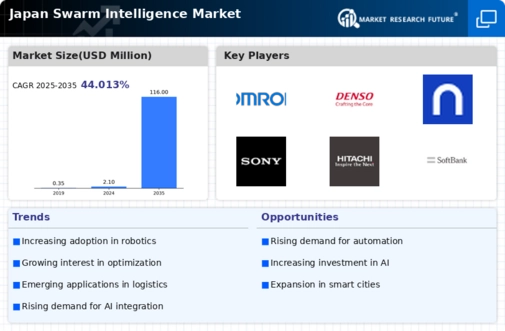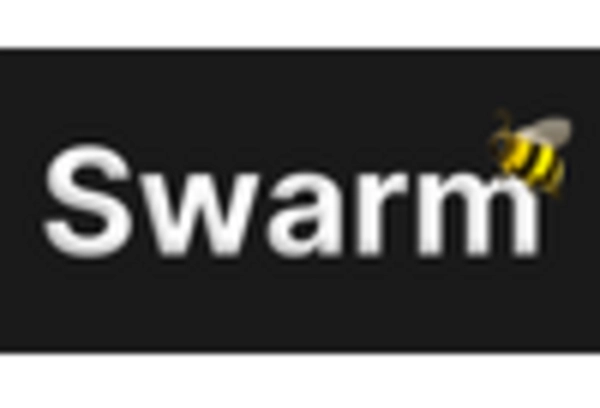Increased Focus on Smart Cities
The concept of smart cities is gaining traction in Japan, which is influencing the swarm intelligence market. As urban areas strive to become more efficient and sustainable, the integration of swarm intelligence technologies is seen as a viable solution. These technologies can optimize traffic management, energy consumption, and waste management systems. Recent studies indicate that the smart city market in Japan is expected to reach $100 billion by 2027, with swarm intelligence playing a crucial role in achieving these goals. The swarm intelligence market is likely to benefit from this trend, as municipalities and private enterprises invest in innovative solutions that enhance urban living. This focus on smart cities may drive demand for swarm-based applications, further propelling market growth.
Government Initiatives and Funding
In Japan, government initiatives aimed at promoting technological innovation are significantly impacting the swarm intelligence market. The Japanese government has launched various funding programs to support research and development in artificial intelligence and robotics. For instance, the Ministry of Economy, Trade and Industry (METI) has allocated substantial budgets to foster advancements in swarm intelligence applications. This financial backing is expected to stimulate growth within the swarm intelligence market, as startups and established companies alike leverage these resources to develop cutting-edge solutions. Furthermore, the government's commitment to enhancing Japan's position as a leader in technology is likely to create a favorable environment for the swarm intelligence market, encouraging collaboration between academia and industry.
Rising Demand for Advanced Robotics
The swarm intelligence market in Japan is experiencing a notable surge in demand for advanced robotics solutions. This trend is driven by the need for automation across various sectors, including manufacturing and healthcare. As industries seek to enhance efficiency and reduce operational costs, swarm intelligence technologies are being integrated into robotic systems. According to recent data, the robotics sector in Japan is projected to grow at a CAGR of 15% over the next five years. This growth is likely to propel the swarm intelligence market, as companies increasingly adopt collaborative robots that utilize swarm algorithms to optimize tasks. The swarm intelligence market is thus positioned to benefit from this rising demand, as organizations look for innovative ways to improve productivity and streamline operations.
Advancements in Machine Learning Algorithms
The swarm intelligence market in Japan is being propelled by advancements in machine learning algorithms. As these algorithms become more sophisticated, they enable more effective swarm-based solutions across various applications, including logistics, healthcare, and transportation. The integration of machine learning with swarm intelligence allows for improved decision-making processes and enhanced adaptability in dynamic environments. Recent reports suggest that the machine learning market in Japan is expected to grow at a CAGR of 20% over the next five years, which could positively impact the swarm intelligence market. Companies are likely to invest in developing hybrid systems that leverage both swarm intelligence and machine learning, thereby enhancing their operational capabilities and driving market growth.
Growing Interest in Environmental Monitoring
Environmental concerns are increasingly influencing the swarm intelligence market in Japan. With rising awareness of climate change and pollution, there is a growing interest in utilizing swarm intelligence for environmental monitoring and management. Technologies that mimic natural swarming behaviors can be employed to monitor air quality, water resources, and biodiversity. The Japanese government has recognized the potential of these technologies and is investing in research initiatives aimed at developing swarm-based environmental solutions. The swarm intelligence market is likely to see growth as organizations and governmental bodies seek to implement these innovative approaches to address environmental challenges. This trend may lead to collaborations between technology providers and environmental agencies, fostering advancements in the field.

















Leave a Comment